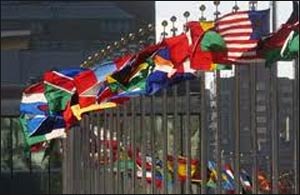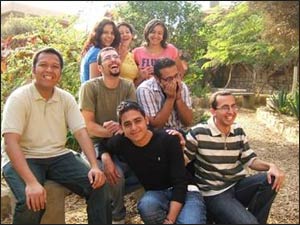By Thomas Uthup
THE U.N. ALLIANCE OF CIVILIZATIONS TURNS EIGHT
Death, destruction and United Nations preventive military efforts often command public and media attention. The other purposes and activities of the U.N. – concentrating, for instance, on developing respect for rights, preventing discrimination, economic development, and cultural coexistence – receive less attention.

One of these low-flying efforts is the emergence of the United Nations Alliance of Civilizations (UNAOC) initiative, created to bridge cultures – including religions – and counter extremism and polarization. UNAOC is relatively new on the world scene. The initiative, co-sponsored by Spain and Turkey, was announced by Secretary-General Kofi Annan in 2005.
Structurally, the agency reports to the office of the Secretary-General. It is funded entirely through voluntary contributions, largely from governments. Substantial input into the objectives and activities of the Alliance is received through its Group of Friends, comprising countries and intergovernmental organizations.

Global forums of the Alliance provide an opportunity for high-profile political and civil society leaders, current and potential partners, and youth to discuss issues and provide inputs into its future activities. The main pillars of the UNAOC are education, media, migration, and youth.
The Alliances’ objectives – building bridges between cultures, encouraging diversity, and countering extremism – inevitably raise the issue of religion. The incoming High Representative for the UNAOC, Mr. Nassir Abdulaziz Al-Nasser, has said: “Religion is obviously important for a majority of human beings, as a source of meaning, belonging, moral guidance, inspiration for action. . . .religions and beliefs influence our living together in diversity in an increasingly interconnected world.”
The Alliance is one of the few UN arenas to explicitly recognize the important role of religion and religious actors in the world today. Remarking on the importance of faith in UNAOC work, Mr. Marc Scheuer, its director, said, “… the U.N. Alliance of Civilizations is paying growing attention to the bridge-building benefits of interfaith activities through concrete actions. Within its limited resources, it seeks to encourage interfaith cooperation … with the help of partners.”
Three primary areas where the Alliance pursues its vision are educating about religions and beliefs, building nuanced understandings of the role of religion and faith-based issues; and promoting youth and innovative interfaith projects.
Education about Religions and Beliefs (ERB) – A major call at the UNAOC Madrid forum was to build an educational clearinghouse on religions and beliefs. The site, launched in 2009, has news; resources such as syllabi, lesson plans, useful links; organizations (institutions, associations, NGOs); a journal with articles and links; and events relevant to education about religions and beliefs.
The ERB site works with the help of partners and collaborators (academic institutions, NGOs, and intergovernmental organizations) from around the world and maintains an online community. This online community has started to hold actual events. For instance, the Guerrand-Hermés Foundation brought together academics, NGOs, and faith leaders to discuss “Religion, Spirituality, and Education for Human Flourishing” in Marrakesh, Morocco, early in 2012. With the British Council and the University of Missouri journalism school, the Alliance’s media program produced 100 Questions on Islam in the form of short two-minute videos.
Building Understanding of the Role of Religion – Through public events and publications and with partners, the Alliance highlights and analyzes the role of religion in public affairs. ERB Partner, the Berkley Center for Religion, Peace and World Affairs at Georgetown University, presented the results of their research on faith-inspired organizations and development in early 2011 at the United Nations. The Center, in cooperation with the Swiss government and UNAOC’s migration program, also produced a working paper and policy brief on collaboration across communities (in particular between religious and non-religious actors) regarding humanitarianism and development. The Alliance’s Global Experts Program, a media project, launched a series of articles on Religion & the Public Space written by a diverse group of experts and published in newspapers around the world.
Promoting Interfaith Projects – In October 2010, the U.N. General Assembly established World Interfaith Harmony Week, to be observed in the first week of February each year subsequently. The Alliance takes a lead role in promoting this activity, growing each year, with thousands of events world-wide now.

Building a global interfaith community of young people is crucial to the future of interfaith efforts at the global level. The Youth Solidarity Fund competition provides small grants to youth-led initiatives that promote long-term constructive relationships between people from diverse cultural, religious backgrounds. For instance, in 2008, the Catholic student group, Pax Romana, won for a project bringing together Catholic and Muslim students in Egypt, Tanzania, and Canada.
The Intercultural Innovation Award, a project of the Alliance and BMW, the auto manufacturer, aims to identify most innovative grassroots projects to bridge cultures – including religions. One of the 2011 winners was MEJDI Tours, a joint Jewish-Arab tour operator offering custom tours to Middle East countries. Their flagship project, the ‘Dual Narrative’ tour, is led by Israeli and Palestinian peacebuilders.
Interfaith activists at the U.N. promoting this year’s World Interfaith Harmony Week Photo: UNAOC
The United Nations Alliance of Civilizations has taken a few small steps to building a global interfaith community bringing together governments, civil society, academia, corporations and foundations, and youth.
The growth and sustainability of the Alliance will depend, in part, on successfully addressing some critical issues:
- The current emphasis on Abrahamic religions is understandable from a political point of view, but hampers a truly global understanding of religions and beliefs.
- Resources have been inadequate. Governments, the main funders of UNAOC, are increasingly being squeezed by decreasing budgets. Unless activities weight in their interests, countries are reluctant to spend money on projects involving religion. As a result, difficult issues become divisive.
- Regarding personnel, the Alliance currently lacks any specialists on religion or interfaith issues. This can lead to coordination issues and a lack of diversity and freshness among the religious leaders and experts invited to speak at Alliance events.
Building a global interfaith community geared towards concrete actions – beyond dialogue as pure talk – would be a logical goal for the Alliance, in relationship to its seasoned partners along with new ones, such as the King Abdullah Bin Abdulaziz International Center for Interreligious and Intercultural Dialogue in Vienna (KAICIID).


